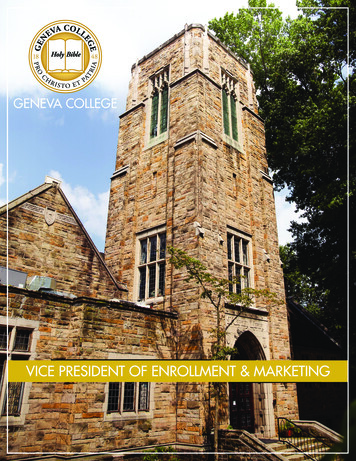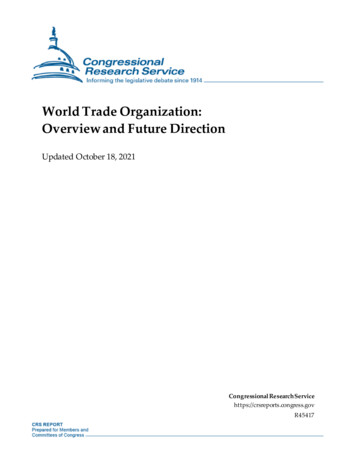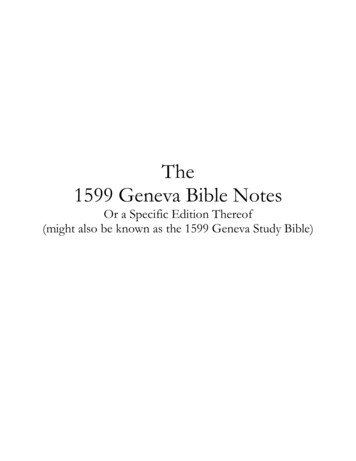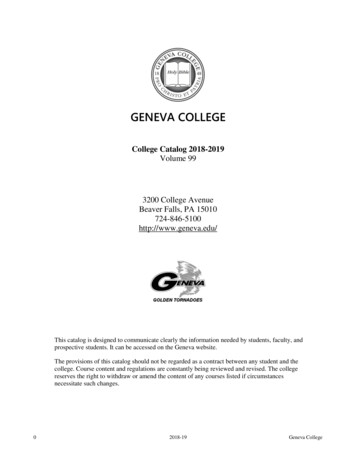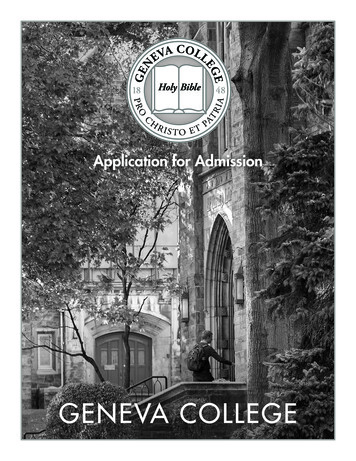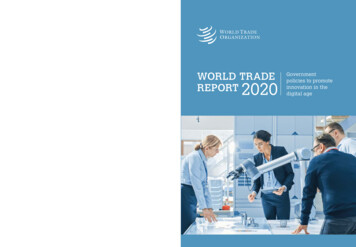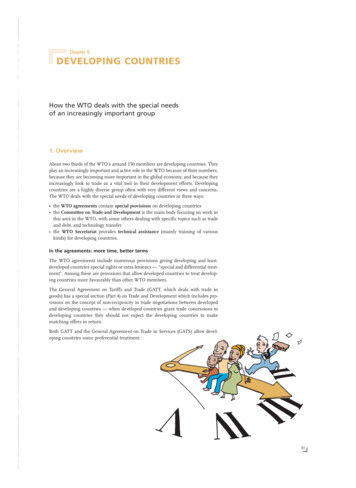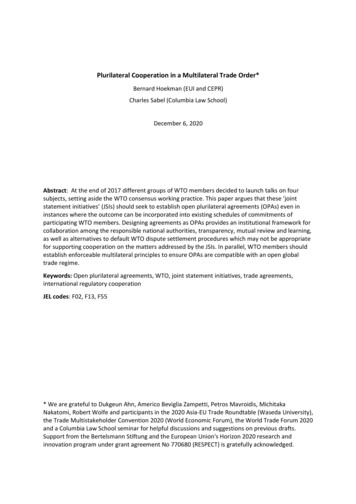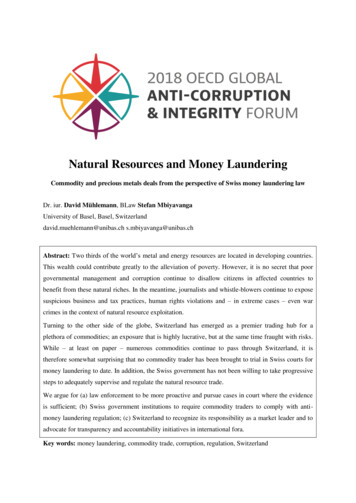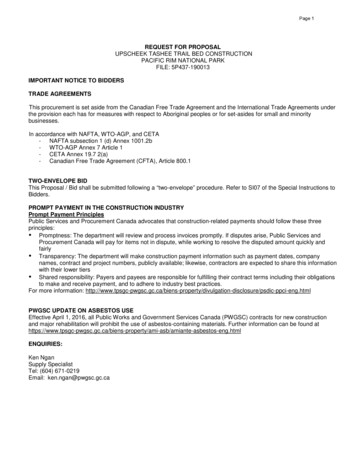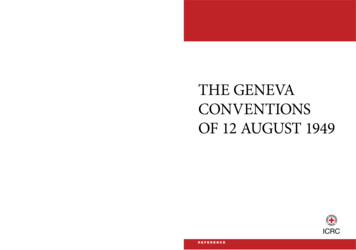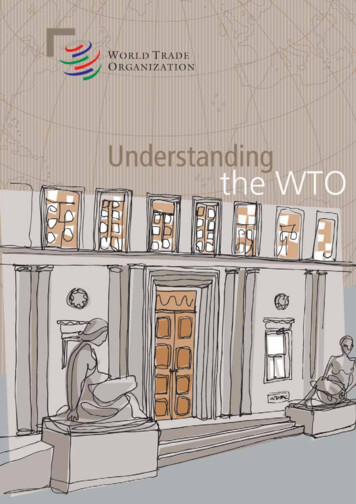
Transcription
The WTOFifth editionPreviously published as “Trading into the Future”Location: Geneva, SwitzerlandEstablished: 1 January 1995Created by: Uruguay Round negotiations (1986–94)Membership: 153 countries (since 23 July 2008)Budget: 196 million Swiss francs for 2011Secretariat staff: 640Head: Pascal Lamy (Director-General)Written and published by theWorld Trade OrganizationInformation and External Relations Division 2011 WTOFunctions: Administering WTO trade agreements Forum for trade negotiations Handling trade disputes Monitoring national trade policies Technical assistance and training for developing countries Cooperation with other international organizationsAn up-to-date version of this text also appears on the WTO website(http://www.wto.org, click on “the WTO”), where it isregularly updated to reflect developments in the WTO.Contact the WTO Information Divisionrue de Lausanne 154, CH–1211 Genève 21, SwitzerlandTel: (41–22) 739 5007/5190 Fax: (41–22) 739 54 58e-mail: enquiries@wto.orgContact WTO Publicationsrue de Lausanne 154, CH–1211 Genève 21, SwitzerlandTel: (41–22) 739 5208/5308 Fax: (41–22) 739 5792e-mail: publications@wto.orgJuly 2011ISBN: 978-92-870-3748-0
8462 P 001 007 Q625/01/0815:24Page 1Understanding the WTO
1008 0073 P 001 007 Q613/08/105:40Page 2ABBREVIATIONSSome of the abbreviations and acronyms used in the WTO:ACPITOInternational Trade OrganizationMEAMultilateral environmental agreementAfrican, Caribbean and Pacific GroupMERCOSURSouthern Common Market(Lomé Convention and Cotonu Agreement)MFAMultifibre Arrangement (replaced by ATC)AD, A-DAnti-dumping measuresMFNMost-favoured-nationAFTAASEAN Free Trade AreaMTNMultilateral trade negotiationsAMSAggregate measurement of supportNAFTANorth American Free Trade Agreement(agriculture)PSEProducer subsidy equivalent (agriculture)APECAsia-Pacific Economic CooperationPSIPre-shipment inspectionASEANAssociation of Southeast Asian NationsS&D, SDTSpecial and differential treatmentATCAgreement on Textiles and ClothingCBDConvention on Biological DiversityCCC(former) Customs Co-operation Council(now WCO)CER[Australia New Zealand] Closer EconomicRelations [Trade Agreement] (also ANCERTA)COMESACommon Market for Eastern andSouthern AfricaCTDCommittee on Trade and DevelopmentCTECommittee on Trade and EnvironmentCVDCountervailing duty (subsidies)DDADoha Development AgendaDSBDispute Settlement BodyDSUDispute Settlement UnderstandingEFTAEuropean Free Trade AssociationEUEuropean Union(for developing countries)SAARCSouth Asian Association for RegionalCooperationSDRSpecial Drawing Rights (IMF)SELALatin American Economic SystemSPSSanitary and phytosanitary measuresTBTTechnical barriers to tradeTMBTextiles Monitoring BodyTNCTrade Negotiations CommitteeTPRBTrade Policy Review BodyTPRMTrade Policy Review MechanismTRIMsTrade-related investment measuresTRIPSTrade-related aspects of intellectualproperty rightsUNUnited NationsUN Conference on Trade and DevelopmentFAOFood and Agriculture OrganizationUNCTADGATSGeneral Agreement on Trade in ServicesUNDPUN Development ProgrammeGATTGeneral Agreement on Tariffs and TradeUNEPUN Environment ProgrammeGSPGeneralized System of PreferencesUPOVInternational Union for the ProtectionHSHarmonized Commodity Descriptionof New Varieties of Plantsand Coding SystemURUruguay RoundInterim Commission for theVERVoluntary export restraintInternational Trade OrganizationVRAVoluntary restraint agreementILOInternational Labour OrganizationWCOWorld Customs OrganizationIMFInternational Monetary FundWIPOWorld Intellectual Property OrganizationITCInternational Trade CentreWTOWorld Trade OrganizationICITOFor a comprehensive list of abbreviations and glossary of terms used in international trade, see, for example:Walter Goode, Dictionary of Trade Policy Terms, 5th edition, WTO/Cambridge University Press, 2007.This and many other publications on the WTO and trade are available from:WTO Publications, World Trade Organization, Centre William Rappard, Rue de Lausanne 154, CH–1211 Geneva, Switzerland.Tel ( 41–22) 739 5208/5308. Fax: ( 41–22) 739 5792. E-mail: publications@wto.org2
8462 P 001 007 Q625/01/0815:24Page 3ON THE WEBSITEYou can find more information on WTOactivities and issues on the WTO website.The site is created around “gateways” leading to various subjects — for example, the “trade topics” gateway or the “DohaDevelopment Agenda” gateway. Each gateway provides linksto all material on its subject.References in this text show you where to find the material.This is in the form of a path through gateways, starting withone of the navigation links in the top right of the homepageor any other page on the site. For example, to find material onthe agriculture negotiations, you go through this series ofgateways and links:www.wto.org trade topics goods agriculture agriculture negotiationsYou can follow this path, either by clicking directly on thelinks, or via drop-down menus that will appear in mostbrowsers when you place your cursor over the “trade topics”link at the top of any web page on the site.A word of caution: the fine printWhile every effort has been made to ensure the accuracy ofthe text in this booklet, it cannot be taken as an official legalinterpretation of the agreements.In addition, some simplifications are used in order to keepthe text simple and clear.In particular, the words “country” and “nation” are frequentlyused to describe WTO members, whereas a few members areofficially “customs territories”, and not necessarily countriesin the usual sense of the word (see list of members). Thesame applies when participants in trade negotiations arecalled “countries” or “nations”.Where there is little risk of misunderstanding, the word“member” is dropped from “member countries (nations, governments)”, for example in the descriptions of the WTOagreements. Naturally, the agreements and commitments donot apply to non-members.In some parts of the text, GATT is described as an “international organization”. The phrase reflects GATT’s de facto rolebefore the WTO was created, and it is used simplistically hereto help readers understand that role. As the text points out,this role was always ad hoc, without a proper legal foundation.International law did not recognize GATT as an organization.For simplicity, the text uses the term “GATT members”.Officially, since GATT was a treaty and not a legally-establishedorganization, GATT signatories were “contracting parties”.And, for easier reading, article numbers in GATT and GATS havebeen translated from Roman numbers into European digits.3
8462 P 001 007 Q625/01/0815:24Page 4CONTENTSCHAPTER 1BASICS1. What is the World Trade Organization?CHAPTER 39SETTLING DISPUTES1. A unique contribution552. Principles of the trading system102. The panel process593. The case for open trade133. Case study: the timetable in practice604. The GATT years: from Havana to Marrakesh15CHAPTER 45. The Uruguay Round181. Regionalism: friends or rivals?632. The environment: a specific concern65CHAPTER 2THE AGREEMENTSCROSS-CUTTING AND NEW ISSUES1. Overview: a navigational guide233. Investment, competition, procurement, simpler procedures722. Tariffs: more bindings and closer to zero254. Electronic commerce743. Agriculture: fairer markets for farmers265. Labour standards: highly controversial744. Standards and safety305. Textiles: back in the mainstream316. Services: rules for growth and investment337. Intellectual property: protection and enforcement398. Anti-dumping, subsidies, safeguards: contingencies, etc449. Non-tariff barriers: red tape, etcImport licensing: keeping procedures clearRules for the valuation of goods at customsPreshipment inspection: a further check on importsRules of origin: made in . where?Investment measures: reducing trade distortions49494950505110. Plurilaterals: of minority interest5111. Trade policy reviews: ensuring transparency534
8462 P 001 007 Q625/01/08CHAPTER 515:24Page 5THE DOHA AGENDAImplementation-related issues and concerns (par 12)Agriculture (pars 13, 14)Services (par 15)Market access for non-agricultural products (par 16)Trade-related aspects of intellectual property rights(TRIPS) (pars 17–19)Relationship between trade and investment (pars 20–22)Interaction between trade and competition policy (pars 23–25)Transparency in government procurement (par 26)Trade facilitation (par 27)WTO rules: anti-dumping and subsidies (par 28)WTO rules: regional trade agreements (par 29)Dispute Settlement Understanding (par 30)Trade and environment (pars 31–33)Electronic commerce (par 34)Small economies (par 35)Trade, debt and finance (par 36)Trade and technology transfer (par 37)Technical cooperation and capacity building (pars 38–41)Least-developed countries (pars 42, 43)Special and differential treatment (par 44)Cancún 2003, Hong Kong 2005CHAPTER 6DEVELOPING COUNTRIES778081811. Overview932. Committees953. WTO technical cooperation9682848485858686878789898989899091914. Some issues raised97CHAPTER 7THE ORGANIZATION1. Whose WTO is it anyway?1012. Membership, alliances and bureaucracy1053. The Secretariat1084. Special policies109Current WTO members1125
8462 P 001 007 Q628/01/089:45Page 6
8462 P 001 007 Q628/01/089:45Page 7The first step is to talk. Essentially,the WTO is a place where membergovernments go, to try to sort out thetrade problems they face with eachother.At its heart are WTO agreements,negotiated and signed by the bulkof the world’s trading nations.But the WTO is not just aboutliberalizing trade, and in somecircumstances its rules supportmaintaining trade barriers —for example to protect consumers,prevent the spread of diseaseor protect the environment.7
8462 P 001 007 Q625/01/0815:24Page 7The first step is to talk. Essentially,the WTO is a place where membergovernments go, to try to sort out thetrade problems they face with eachother.At its heart are WTO agreements,negotiated and signed by the bulkof the world’s trading nations.But the WTO is not just aboutliberalizing trade, and in somecircumstances its rules supportmaintaining trade barriers —for example to protect consumers,prevent the spread of diseaseor protect the environment.7
3817 P 008 021 Q611/12/0816:59Page 8The “table” in action: WTO Trade Negotiations Committee, meeting in Geneva, 14 September 2005
3817 P 008 021 Q611/12/0816:59Page 9Chapter 1BASICSThe WTO was born out of negotiations;everything the WTO does is the result of negotiations1. What is the World Trade Organization?Simply put: the World Trade Organization (WTO) deals with the rules of tradebetween nations at a global or near-global level. But there is more to it than that.Is it a bird, is it a plane?There are a number of ways of looking at the WTO. It’s an organization for liberalizing trade. It’s a forum for governments to negotiate trade agreements. It’s a placefor them to settle trade disputes. It operates a system of trade rules. (But it’s notSuperman, just in case anyone thought it could solve — or cause — all the world’sproblems!). OR IS IT A TABLE?Participants in a recent radio discussionon the WTO were full of ideas. The WTOshould do this, the WTO should do that,they said.Above all, it’s a negotiating forum Essentially, the WTO is a place where membergovernments go, to try to sort out the trade problems they face with each other. The firststep is to talk. The WTO was born out of negotiations, and everything the WTO doesis the result of negotiations. The bulk of the WTO’s current work comes from the1986–94 negotiations called the Uruguay Round and earlier negotiations under theGeneral Agreement on Tariffs and Trade (GATT). The WTO is currently the host tonew negotiations, under the “Doha Development Agenda” launched in 2001.Where countries have faced trade barriers and wanted them lowered, the negotiations have helped to liberalize trade. But the WTO is not just about liberalizingtrade, and in some circumstances its rules support maintaining trade barriers — forexample to protect consumers or prevent the spread of disease.It’s a set of rules At its heart are the WTO agreements, negotiated and signedby the bulk of the world’s trading nations. These documents provide the legalground-rules for international commerce. They are essentially contracts, bindinggovernments to keep their trade policies within agreed limits. Although negotiatedand signed by governments, the goal is to help producers of goods and services,exporters, and importers conduct their business, while allowing governments tomeet social and environmental objectives.One of them finally interjected: “Wait aminute. The WTO is a table. People sitround the table and negotiate. What doyou expect the table to do?”
8462 P 008 021 Q625/01/0813:06Page 10‘Multilateral’ trading system . i.e. the system operated by the WTO.Most nations — including almost all themain trading nations — are members ofthe system. But some are not, so “multilateral” is used to describe the systeminstead of “global” or “world”.In WTO affairs, “multilateral” also contrasts with actions taken regionally or byother smaller groups of countries. (This isdifferent from the word’s use in otherareas of international relations where, forexample, a “multilateral” securityarrangement can be regional.)The system’s overriding purpose is to help trade flow as freely as possible — so longas there are no undesirable side-effects — because this is important for economicdevelopment and well-being. That partly means removing obstacles. It also meansensuring that individuals, companies and governments know what the trade rules arearound the world, and giving them the confidence that there will be no suddenchanges of policy. In other words, the rules have to be “transparent” and predictable.And it helps to settle disputes This is a third important side to the WTO’s work.Trade relations often involve conflicting interests. Agreements, including thosepainstakingly negotiated in the WTO system, often need interpreting. The most harmonious way to settle these differences is through some neutral procedure based onan agreed legal foundation. That is the purpose behind the dispute settlementprocess written into the WTO agreements.Born in 1995, but not so youngThe WTO began life on 1 January 1995, but its trading system is half a century older.Since 1948, the General Agreement on Tariffs and Trade (GATT) had provided therules for the system. (The second WTO ministerial meeting, held in Geneva in May1998, included a celebration of the 50th anniversary of the system.)It did not take long for the General Agreement to give birth to an unofficial, de factointernational organization, also known informally as GATT. Over the years GATTevolved through several rounds of negotiations.The last and largest GATT round, was the Uruguay Round which lasted from 1986to 1994 and led to the WTO’s creation. Whereas GATT had mainly dealt with tradein goods, the WTO and its agreements now cover trade in services, and in tradedinventions, creations and designs (intellectual property).2. Principles of the trading systemThe principlesThe trading system should be . without discrimination — a countryshould not discriminate between its trading partners (giving them equally “mostfavoured-nation” or MFN status); and itshould not discriminate between its ownand foreign products, services or nationals(giving them “national treatment”); freer — barriers coming down throughnegotiation; predictable — foreign companies, investorsand governments should be confidentthat trade barriers (including tariffs andnon-tariff barriers) should not be raisedarbitrarily; tariff rates and market-openingcommitments are “bound”in the WTO; more competitive — discouraging“unfair” practices such as export subsidiesand dumping products at below cost togain market share; more beneficial for less developed countries — giving them more time to adjust,greater flexibility, and special privileges.10The WTO agreements are lengthy and complex because they are legal texts coveringa wide range of activities. They deal with: agriculture, textiles and clothing, banking,telecommunications, government purchases, industrial standards and product safety, food sanitation regulations, intellectual property, and much more. But a numberof simple, fundamental principles run throughout all of these documents. Theseprinciples are the foundation of the multilateral trading system.A closer look at these principles:Trade without discrimination1. Most-favoured-nation (MFN): treating other people equallyUnder the WTOagreements, countries cannot normally discriminate between their trading partners. Grant someone a special favour (such as a lower customs duty rate for one oftheir products) and you have to do the same for all other WTO members.This principle is known as most-favoured-nation (MFN) treatment (see box). It is soimportant that it is the first article of the General Agreement on Tariffs and Trade(GATT), which governs trade in goods. MFN is also a priority in the GeneralAgreement on Trade in Services (GATS) (Article 2) and the Agreement on TradeRelated Aspects of Intellectual Property Rights (TRIPS) (Article 4), although in eachagreement the principle is handled slightly differently. Together, those three agreements cover all three main areas of trade handled by the WTO.
8462 P 008 021 Q625/01/0813:06Page 11Some exceptions are allowed. For example, countries can set up a free trade agreement that applies only to goods traded within the group — discriminating againstgoods from outside. Or they can give developing countries special access to theirmarkets. Or a country can raise barriers against products that are considered to betraded unfairly from specific countries. And in services, countries are allowed, inlimited circumstances, to discriminate. But the agreements only permit these exceptions under strict conditions. In general, MFN means that every time a country lowers a trade barrier or opens up a market, it has to do so for the same goods or services from all its trading partners — whether rich or poor, weak or strong.2. National treatment: Treating foreigners and locals equallyImported and locallyproduced goods should be treated equally — at least after the foreign goods haveentered the market. The same should apply to foreign and domestic services, and toforeign and local trademarks, copyrights and patents. This principle of “nationaltreatment” (giving others the same treatment as one’s own nationals) is also foundin all the three main WTO agreements (Article 3 of GATT, Article 17 of GATS andArticle 3 of TRIPS), although once again the principle is handled slightly differently in each of these.National treatment only applies once a product, service or item of intellectual property has entered the market. Therefore, charging customs duty on an import is nota violation of national treatment even if locally-produced products are not chargedan equivalent tax.Why ‘most-favoured’?This sounds like a contradiction. It suggests special treatment, but in the WTO itactually means non-discrimination —treating virtually everyone equally.This is what happens. Each member treatsall the other members equally as “mostfavoured” trading partners. If a countryimproves the benefits that it gives to onetrading partner, it has to give the same“best” treatment to all the other WTOmembers so that they all remain “mostfavoured”.Most-favoured nation (MFN) status didnot always mean equal treatment. Thefirst bilateral MFN treaties set up exclusiveclubs among a country’s “most-favoured”trading partners. Under GATT and nowthe WTO, the MFN club is no longerexclusive. The MFN principle ensures thateach country treats its over-140 fellowmembers equally.But there are some exceptions .Freer trade: gradually, through negotiationLowering trade barriers is one of the most obvious means of encouraging trade. Thebarriers concerned include customs duties (or tariffs) and measures such as importbans or quotas that restrict quantities selectively. From time to time other issuessuch as red tape and exchange rate policies have also been discussed.Since GATT’s creation in 1947–48 there have been eight rounds of trade negotiations. A ninth round, under the Doha Development Agenda, is now underway. Atfirst these focused on lowering tariffs (customs duties) on imported goods. As aresult of the negotiations, by the mid-1990s industrial countries’ tariff rates onindustrial goods had fallen steadily to less than 4%But by the 1980s, the negotiations had expanded to cover non-tariff barriers ongoods, and to the new areas such as services and intellectual property.Opening markets can be beneficial, but it also requires adjustment. The WTO agreements allow countries to introduce changes gradually, through “progressive liberalization”. Developing countries are usually given longer to fulfil their obligations.Predictability: through binding and transparencySometimes, promising not to raise a trade barrier can be as important as loweringone, because the promise gives businesses a clearer view of their future opportunities. With stability and predictability, investment is encouraged, jobs are created andconsumers can fully enjoy the benefits of competition — choice and lower prices.The multilateral trading system is an attempt by governments to make the businessenvironment stable and predictable.11
8462 P 008 021 Q625/01/0813:06Page 12The Uruguay Roundincreased bindingsPercentages of tariffs bound before andafter the 1986–94 talksDeveloped countriesDeveloping countriesTransition economiesBeforeAfter782173997398(These are tariff lines, so percentages arenot weighted according to trade volumeor value)In the WTO, when countries agree to open their markets for goods or services, they“bind” their commitments. For goods, these bindings amount to ceilings on customs tariff rates. Sometimes countries tax imports at rates that are lower than thebound rates. Frequently this is the case in developing countries. In developed countries the rates actually charged and the bound rates tend to be the same.A country can change its bindings, but only after negotiating with its trading partners, which could mean compensating them for loss of trade. One of the achievements of the Uruguay Round of multilateral trade talks was to increase the amountof trade under binding commitments (see table). In agriculture, 100% of productsnow have bound tariffs. The result of all this: a substantially higher degree of market security for traders and investors.The system tries to improve predictability and stability in other ways as well. Oneway is to discourage the use of quotas and other measures used to set limits onquantities of imports — administering quotas can lead to more red-tape and accusations of unfair play. Another is to make countries’ trade rules as clear and public(“transparent”) as possible. Many WTO agreements require governments to disclose their policies and practices publicly within the country or by notifying theWTO. The regular surveillance of national trade policies through the Trade PolicyReview Mechanism provides a further means of encouraging transparency bothdomestically and at the multilateral level.Promoting fair competitionThe WTO is sometimes described as a “free trade” institution, but that is not entirely accurate. The system does allow tariffs and, in limited circumstances, other formsof protection. More accurately, it is a system of rules dedicated to open, fair andundistorted competition.The rules on non-discrimination — MFN and national treatment — are designed tosecure fair conditions of trade. So too are those on dumping (exporting at below costto gain market share) and subsidies. The issues are complex, and the rules try toestablish what is fair or unfair, and how governments can respond, in particular bycharging additional import duties calculated to compensate for damage caused byunfair trade.Many of the other WTO agreements aim to support fair competition: in agriculture,intellectual property, services, for example. The agreement on government procurement (a “plurilateral” agreement because it is signed by only a few WTO members)extends competition rules to purchases by thousands of government entities inmany countries. And so on.Encouraging development and economic reformThe WTO system contributes to development. On the other hand, developing countries need flexibility in the time they take to implement the system’s agreements. Andthe agreements themselves inherit the earlier provisions of GATT that allow for special assistance and trade concessions for developing countries.Over three quarters of WTO members are developing countries and countries intransition to market economies. During the seven and a half years of the UruguayRound, over 60 of these countries implemented trade liberalization programmesautonomously. At the same time, developing countries and transition economies weremuch more active and influential in the Uruguay Round negotiations than in any previous round, and they are even more so in the current Doha Development Agenda.12
8462 P 008 021 Q625/01/0813:06Page 13At the end of the Uruguay Round, developing countries were prepared to take onmost of the obligations that are required of developed countries. But the agreementsdid give them transition periods to adjust to the more unfamiliar and, perhaps, difficult WTO provisions — particularly so for the poorest, “least-developed” countries.A ministerial decision adopted at the end of the round says better-off countriesshould accelerate implementing market access commitments on goods exported bythe least-developed countries, and it seeks increased technical assistance for them.More recently, developed countries have started to allow duty-free and quota-freeimports for almost all products from least-developed countries. On all of this, theWTO and its members are still going through a learning process. The current DohaDevelopment Agenda includes developing countries’ concerns about the difficultiesthey face in implementing the Uruguay Round agreements.3. The case for open tradeTRUE AND NON-TRIVIAL?Nobel laureate Paul Samuelson was oncechallenged by the mathematicianStanislaw Ulam to “name me one proposition in all of the social sciences which isboth true and non-trivial.”Samuelson’s answer? Comparative advantage.“That it is logically true need not beargued before a mathematician; that it isnot trivial is attested by the thousands ofimportant and intelligent men who havenever been able to grasp the doctrine forthemselves or to believe it after it wasexplained to them.”The economic case for an open trading system based on multilaterally agreed rules issimple enough and rests largely on commercial common sense. But it is also supported by evidence: the experience of world trade and economic growth since the SecondWorld War. Tariffs on industrial products have fallen steeply and now average less than5% in industrial countries. During the first 25 years after the war, world economicgrowth averaged about 5% per year, a high rate that was partly the result of lower tradebarriers. World trade grew even faster, averaging about 8% during the period.The data show a definite statistical link between freer trade and economic growth.Economic theory points to strong reasons for the link. All countries, including thepoorest, have assets — human, industrial, natural, financial — which they can employto produce goods and services for their domestic markets or to compete overseas.Economics tells us that we can benefit when these goods and services are traded.Simply put, the principle of “comparative advantage” says that countries prosper firstby taking advantage of their assets in order to concentrate on what they can producebest, and then by trading these products for products that other countries produce best.In other words, liberal trade policies — policies that allow the unrestricted flow ofgoods and services — sharpen competition, motivate innovation and breed success.They multiply the rewards that result from producing the best products, with thebest design, at the best price.But success in trade is not static. The ability to compete well in particular productscan shift from company to company when the market changes or new technologiesmake cheaper and better products possible. Producers are encouraged to adaptgradually and in a relatively painless way. They can focus on new products, find anew “niche” in their current area or expand into new areas.Experience shows that competitiveness can also shift between whole countries. Acountry that may have enjoyed an advantage because of lower labour costs orbecause it had good supplies of some natural resources, could also become uncompetitive in some goods or services as its economy develops. However, with the stimulus of an open economy, the country can move on to become competitive insome other goods or services. This is normally a gradual process.World trade and productionhave acceleratedBoth trade and GDP fell in the late 1920s,before bottoming out in 1932. After WorldWar II, both have risen exponentially, mostof the time with trade outpacing GDP.(1950 100. Trade and GDP: log scale)2000Merchandise trade1000GDP200100501929/32 38GATTcreated48WTOcreated60708090 199513
8462 P 008 021 Q625/01/0813:06MORE ON THE WEBSITE:www.wto.org resources WTO research and analysisPage 14Nevertheless, the temptation to ward off the challenge of competitive imports isalways present. And richer governments are more likely to yield to the siren call ofprotectionism, for short term political gain — through subsidies, complicated redtape, and hiding behind legitimate policy objectives such as environmental preservation or consumer protection as an excuse to protect producers.Protection ultimately leads to bloated, inefficient producers supplying consumerswith outdated, unattractive products. In the end, factories close and jobs are
2. Principles of the trading system 10 3. The case for open trade 13 4. The GATT years: from Havana to Marrakesh 15 5. The Uruguay Round 18 CHAPTER 2 THE AGREEMENTS 1. Overview: a navigational guide 23 2. Tariffs: more bindings and closer to zero 25 3. Agriculture: fairer markets for farmers 26 4. Standards and safety 30 5. Textiles: back in .
